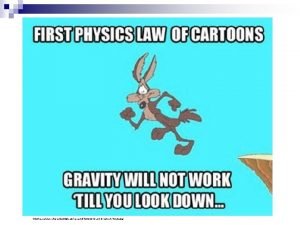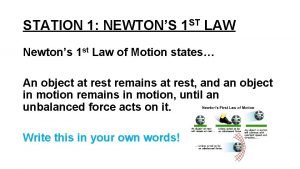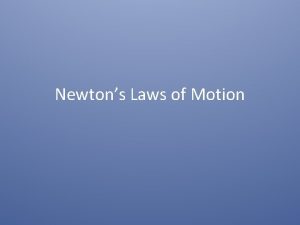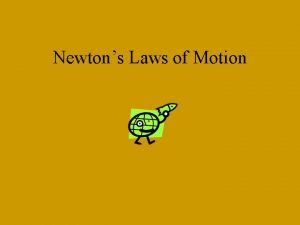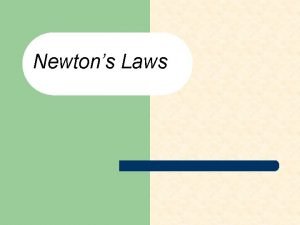NEWTONS LAWS OF MOTION First Law of Motion












- Slides: 12

NEWTON’S LAWS OF MOTION

First Law of Motion: “The Law of Inertia” An object at rest remains at rest, and an object in motion continues in motion, with constant velocity, unless the object experiences a net external force.

• Inertia is the property of an object to resist change in motion. • It is because of inertia that objects like to remain at rest or why objects like to keep moving. • More Mass = More Inertia • The greater an object’s inertia, the greater the force needed to change its motion.

Why don’t things keep on moving forever? ■ So, if an object in motion remains in motion unless acted upon by another force and I pushed my desk across the room, would it keep moving forever? ■ It stops moving because an unbalanced force acts on it. Friction…. ■ Friction is an unbalanced force

Second Law of Motion: “The Law of Acceleration” The acceleration on an object is directly proportional to the magnitude of the net external force, is in the same direction as the net force, and is inversely proportional to the mass of the object “sigma” = sum of all forces, or net force.

Second Law of Motion: “The Law of Acceleration” Net force, the sum of all forces, causes an object to accelerate.

The Definition of Forces are not directly observable, but the effect of force is perceived. Newton’s Second Law defines force as the effect of mass accelerating. A newton is defined as the force required to accelerate one kilogram of mass at a rate of one meter per second squared. Both newtons and pounds are units of force, not mass.

2 nd Law of Motion Question 1. What acceleration will result when a 12 N net force applied to a 3 kg object? 2. A net force of 16 N causes a mass to accelerate at a rate of 5 m/s 2. Determine the mass. 3. How much force is needed to accelerate a 66 kg skier 1 m/sec 2? 4. What is the force on a 1000 kg elevator that is falling freely at 9. 8 m/sec 2?

Third Law of Motion: “The Law of Action. Reaction” Whenever one object exerts a force on a second object, the second object exerts an equal and opposite force on the first. force on object 1 from object 2 force on object 2 from object 1 A hammer and a nail hit each other with equal force. F 2, 1 F 1, 2

Third Law of Motion: continued • Forces always act in pairs • Action-reaction forces always act on different objects –> They are not balanced! • We use action-reaction forces to change our motion

Newton’s Third Law Examples What are the action and reaction forces in these examples?

EXIT SLIP What is the relationship between force and motion?
